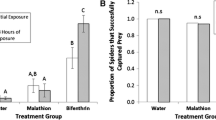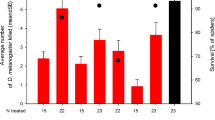Abstract
Spinosad is a neurotoxic pesticide, which is currently used in IPM and organic agriculture. It can affect the survival and ecological function of spiders, which are natural enemies of important agricultural pests. In the laboratory, we carried out tests to determine lethal and sublethal effects of spinosad on mortality, web building, and web characteristics of Agalenatea redii. Spinosad has a lethal effect at the normal application rate (NAR, i.e., 96 g ha−1) causing 35 % mortality (vs 0 % for control) after 4 days and 62 % mortality (vs 14 % for control) after 30 days. For the sublethal effects, web building was affected and fewer spiders built webs when exposed to spinosad (10/37 at NAR and 28/39 at half the NAR vs 35/37 for control group). No delay in web building was observed following exposure. Spider webs showed irregularities in the spiral-thread spacing (parallelism) when exposed to higher doses of spinosad (NAR and half of the NAR). Spinosad also affected prey capture: spiders exposed to spinosad (NAR) showed decreased prey capture efficiency (32 vs 73 % for control). These results showed that spinosad affects the spider predatory behavior (agriculture auxiliaries), which could modify their role in pest biocontrol.




Similar content being viewed by others
References
Agrawal N, Brar DS (2006) Effects of different neem preparations in comparison to synthetic insecticides on the whitefly parasitoid Encarsia sophia (Hymenoptera: Aphelinidae) and the predator Chrysoperla carnea (Neuroptera: Chrysopidae) on cotton under laboratory conditions. J Pest Sci 79:201–207
Ahmed S, Maqsood A (2006) Toxicity of some insecticides on Bracon hebetor under laboratory conditions. Phytoparasitica 34:401–404
Anotaux M, Marchal J, Châline N, Desquilbet L, Leborgne R, Gilbert C, Pasquet A (2012) Ageing alters spider orb-web construction. Anim Behav 84:1113–1121
Benamú MA, Schneider MI, Pineda S, Sanchez NE (2007) Sublethal effects of two neurotoxican insecticides on Araneus pratensis (Araneae: Araneidae). Commun Agric Appl Biol Sci 72:557–559
Benamú MA, Schneider MI, Sánchez NE (2010) Effects of the herbicide glyphosate on biological attributes of Alpaida veniliae (Araneae, Araneidae), in laboratory. Chemosphere 78:871–876
Benamú MA, Schneider MI, Sánchez NE (2013) Short and long-term effects of three neurotoxic insecticides on biological and behavioural attributes of the orb-web spider Alpaida veniliae (Araneae, Araneidae): implications for IPM programs. Ecotox 22:1155–1164
Cisneros JD, Goulson LC, Derwent CD, Penagos I, Hernandez O, Williams T (2002) Toxic effects of spinosad on predatory insects. Biol Control 23:156–163
Dag˘h F, Bahsi SU (2009) Topical and residual toxicity of six pesticides to Orius majusculus. Phytoparasitica 37:399–405
Desneux N, Wajnberg E, Fauvergue X, Privet S, Kaiser L (2004) Sublethal effects of a neurotoxic insecticide on the oviposition behaviour and the patch-time allocation in two aphid parasitoids, Diaeretiella rapae and Aphidius matricariae. Entomol Exp Appl 112:227–235
Desneux N, Decourtye A, Delpuech JM (2007) The sublethal effects of pesticides on beneficial arthropods. Annu Rev Entomol 52:81–106
DowAgroScience (2001) Spinosad Technical Bulletin. Dow Agrosciences LLC, Indianapolis
Eberhard WG (2011) Are smaller animals behavioural limited? Lack of clear constraints in miniature spiders. Anim Behav 81:813–823
Eberhard WG, Hesselberg T (2012) Cues that spiders (Araneae: Araneidae, Tetragnathidae) use to build orbs: lapses in attention to one set of cues because of dissonance withothers? Ethology 118:610–620
Filgus M, Castane C, Gabarra R (1999) Residual toxicity of some insecticides on the predatory bugs Dicyphus tamaninii and Macrolophus caliginosus. Biocontrol 44:89–98
Foelix R (2011) Biology of spiders, 3rd edn. Oxford University Press, New York
Galvan TL, Koch RL, Hutchison WD (2005) Toxicity of commonly used insecticides in sweet corn and soybean to multicolores Asian lady beetle (Coleoptera: Coccinellidae). J Econ Entomol 98:780–789
Gupta S, Dikshit AK (2010) Biopesticides: an ecofriendly approach for pest control. J Biopest 3:186–188
Haseeb M, Liu TX, Jones WA (2004) Effects of selected insecticides on Cotesia plutellae endoparasitoid of Plutella xylostella. Biocontrol 49:33–46
Haynes FK (1988) Subltethal effects of neurotoxic insecticides on insect behaviour. Annu Rev Entomol 33:149–168
Heiling AM, Herberstein ME (2000) Interpretations of orb weaving variability: a review of past and current ideas. Ekológia 19:97–106
Hesselberg T, Vollrath F (2004) The effects of neurotoxins on webgeometry and web- building behaviour in Araneus diadematus Cl. Physiol Behav 82:519–529
IRAC (2014) Insecticide Resistance Action Committee website. http://irac-online.org
Jalali MA, Van Leeuwen T, Tirry L, De Clerq P (2009) Toxicity of selected insecticides to the two-spot ladybird Adalia bipunctata. Phytoparasitica 37:323–326
Johnson A, Revis O, Johnson C (2011) Chemical prey Cues influence the urban microhabitat preferences of the Western black widow spiders, Latrodectus hesperus. J Arachnol 39:449–453
Kirst HA (2010) The spinosyn family of insecticides: realizing the potential of natural products research. J Antibio 63:101–111
Longley M, Jepson P (1996) The influence of insecticide residues on primary parasitoid and hyperparasitoid foraging behaviour in the laboratory. Entomol Exp Appl 81:259–269
Mahdian K, Van Leeuwen T, Tirry L, De Clerq P (2007) Susceptibility of the predatory stinkbug Picromerus bidens to selected insecticides. Biocontrol 52:765–774
Maloney D, Drummond FA (2003) Spider predation in agroecosystems : can spiders effectively control pest populations? The University of Maine: Department of Biological Sciences. Tech Bull 190:32p
Marliac G, Penvern S, Barbier JM, Lescourret F, Capowiez Y (2015) Impact of crop protection strategies on natural enemies in organic apple production. Agro for sustain develop 35:803–813. doi:10.1007/s13593-015-0282-5
Nakata K, Zschokke S (2010) Upside-down spiders build upside-down orb webs: web asymmetry, spider orientation and running speed in Cyclosa. Proc Roy Soc London B 277:3019–3025
Nyffeler M, Benz PG (1987) Spiders in natural pest control: a review. J Appl Entomol 103:321–339
Nyffeler M, Sunderland KD (2003) Composition, abundance and pest control potential of spider communities in agroecosystems: a comparison of European and US studies. Agri Ecosyst Environ 95:579–612
Oerk E, Dehne H (2004) Safeguarding production: losses in major crops and the role of crop protection. Crop Prot 23:275–285
Oerke E (2006) Crop losses to pests. J Agric Sci 144:31–43
Pasquet A, Ridwan A, Leborgne R (1994) Presence of potential prey affects web building in an orb-weaving spider Zygiella x-notata. Anim Behav 47:477–480
Pasquet A, Marchal J, Anotaux M, Leborgne R (2013) Imperfections in perfect architecture: the orb web of spiders. Eur J Entomo 11:493–500
Pasquet A, Marchal J, Anotaux M, Leborgne R (2014) Does building activity influence web construction and web characteristics in an orb-web spider? Zool stud 53:11
Pekar S (2012) Spiders (Araneae) in the pesticide world: an ecotoxicological review. Pest Manag Sci 68:1438–1446
Power AG (2010) Ecosystem services and agriculture: tradeoffs and synergies. Philos Trans R Soc Biol Sci 365:2959–2971
Pruitt JN, DiRienzo N, Kralj-Fiser S, Johnson JC, Sih A (2011) Individual-and condition- dependent effects on habitat choice and choosiness. Behav Ecol Sociobiol 65:1987–1995
Rezác M, Pekár S, Stará J (2010) The negative effect of some selective insecticides on the functional response of a potential biological control agent, the spider Philodromus cespitum. Biocontrol 55:503–510
Rimoldi F, Schneider MI, Ronco AE (2008) Susceptibility of Chrysoperla externa eggs (Neuroptera: Chrysopidae) to conventional and biorational insecticides. Environ Entomol 37:1252–1257
Roberts MJ (1995) Spiders of Britain and Northern Europe. Harper Collins Publishers, London
Saber M, Abedi Z (2013) Effects of methoxyfenozide and pyridalyl on the larval ectoparasitoid Habrobracon hebetor. J Pest Sci 86:685–693
Samu F, Vollrath F (1992) Spider orb web as bioassay for pesticide side effects. Entomol Exp Appl 62:117–124
Samu F, Matthew G, Lake D, Vollrath F (1992) Spider webs are efficient collectors of agronomical spray. Pest Manag Sci 36:47–51
Schneider M, Smagghe G, Pineda S, Vinuela E (2004) Action of insect growth regulator insecticides and spinosad on life history parameters and absorption in third-instar larvae of the endoparasitoid Hyposoter didymator. Biocontrol 31:189–198
Schneider M, Smagghe G, Pineda S, Vinuela E (2008) The ecological impact of four IGR insecticides in adults of Hyposoter didymator (Hym., Ichneumonidae): pharmacokinetics approach. Ecotoxicology 17:181–188
Schneider C, Rasband W, Eliceiri KW (2012) NIH image to Imagej: 25 years of image analysis. Nat Methods 9:671–675
Symondson WOC, Sunderland KD, Greenstone MH (2002) Can generalist predators be effective biocontrol agents? Annu Rev Entomol 47:561–582
Tietjen WJ, Cady AB (2007) Sublethal exposure to a neurotoxic pesticide affects activity rythms and patterns of four spider species. J Arachnol 35:396–406
Toscani C, Leborgne R, Pasquet A (2012) Behavioural analysis of web building anomalies in the orb-weaving spider Zygiella x-notata (Araneae, Araneidae). Arachnol Mitteil 43:79–83
Venner S, Thevenard L, Pasquet A, Leborgne R (2001) Estimation of the web’s capture thread length in orb-weaving spiders: determining the most efficient formula. Ann Entomol Soc Am 94:490–496
Venner S, Bel-Venner MC, Pasquet A, Leborgne R (2003) Body mass-dependant cost of web-building behavior in an orb weaving spider, Zygiella x-notata. Naturwissenschaften 90:269–272
Wiles J, Jepson P (1994) Sublethal effects of deltamethrin residues on the within-crop behaviour and distribution of Coccinella septempunctata. Entomol Exp Appl 72:33–45
Williams T, Valle J, Viñuela E (2003) Is the naturally derived insecticide spinosad® compatible with insect natural enemies? Biocontrol Sci Technol 13:459–475
Witt PN, Reed CF, Peakall DB (1968) A spiders’web. Problems in regulatory biology. Springer, New York
Wyss E, Niggli U, Nentwig W (1995) The impact of spiders on aphid populations in strip- managed apple orchard. J Appl Entomol 119:473–478
Zhao E, Xu Y, Dong MF, Jiang SR, Zhou ZQ, Han LJ (2007) Dissipation and residues of spinosad in eggplant and soil. Bull Environ Contam Toxicol 78:222–225
Acknowledgments
The University of Lorraine (Unit of Research in Functions and Animal Product, URAFPA) supported this study. We thank Joel Couturier who helped us rear the spiders in the laboratory and two anonymous reviewers for their helpful comments on an earlier draft of the paper.
Author information
Authors and Affiliations
Corresponding author
Additional information
Communicated by J. J. Duan.
Alain Pasquet and Nora Tupinier were first co-authors.
Rights and permissions
About this article
Cite this article
Pasquet, A., Tupinier, N., Mazzia, C. et al. Exposure to spinosad affects orb-web spider (Agalenatea redii) survival, web construction and prey capture under laboratory conditions. J Pest Sci 89, 507–515 (2016). https://doi.org/10.1007/s10340-015-0691-x
Received:
Revised:
Accepted:
Published:
Issue Date:
DOI: https://doi.org/10.1007/s10340-015-0691-x




